Add this eBook to your basket to receive access to all 258 records. Our indexes include entries for the spelling mcconnell. In the period you have requested, we have the following 258 records (displaying 131 to 140): These sample scans are from the original record. You will get scans of the full pages or articles where the surname you searched for has been found. Your web browser may prevent the sample windows from opening; in this case please change your browser settings to allow pop-up windows from this site. Residents of Sinclair Street, Helensburgh (1899)
Street directory of Helensburgh from the 22nd edition of the Helensburgh Directory
| Sample scan, click to enlarge
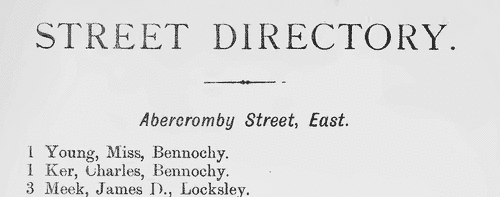
| Boys entering Leeds Grammar School
(1900)
The admission books for Leeds Grammar School from 1820 to 1900 were edited by Edmund Wilson and published in 1906. The series of registers is almost complete for the period, there being in addition admission registers for the Lower (or Commercial) Department from 1856 to 1865, and lists of boys in the school in 1856, and in the Commercial Department in 1861. The entries are arranged by date or term of admission: a sequential number is given first, then surname, christian name, and, after a dash, father's christian name, occupation, and address; another dash, and then the age of the boy at admission, and often his year of leaving (with the abbreviation r. for 'removed' or 'left'). r.* means left without notice; (o) or S. or Stranger or Foreigner indicates a boy not on the foundation. The editor was unable to divine the meaning of the abbreviation (Q) or the asterisks prefixed to most entries in 1856 to 1860, but dutifully copies them into the text. In smaller type he then proceeds, where possible, to add some information about the boy's subsequent career. | Sample scan, click to enlarge
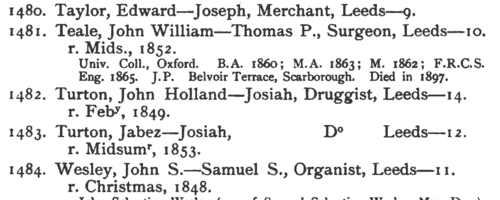
| Missing Next-of-Kin and Heirs-at-Law
(1900)
The Unclaimed Money Registry and Next-of-Kin Advertisement Office of F. H. Dougal & Co., on the Strand in London, published a comprehensive 'Index to Advertisements for Next of Kin, Heirs at Law, Legatees, &c., &c., who have been Advertised for to Claim Money and Property in Great Britain and all Parts of the World; also Annuitants, Shareholders, Intestates, Testators, Missing Friends, Creditors or their Representatives, Claimants, Unclaimed and Reclaimed Dividends and Stock, Citations, Administrations, Rewards for Certificates, Wills, Advertisements, &c., Claims, Unclaimed Balances, Packages, Addresses, Parish Clerks' Notices, Foreign Intestates, &c., &c.' The original list was compiled about 1880, but from materials dating back even into the 18th century: most of the references belong to 1850 to 1880. For each entry only a name is given, sometimes with a placename added in brackets: there may be a reference number, but there is no key by which the original advertisement may be traced. The enquirer of the time had to remit £1 for a 'Full and Authentic Copy of the Original Advertisement, together with name and date of newspaper in which the same appeared'. This appendix to the list was issued in about 1900. | Sample scan, click to enlarge

|  Outstanding soldiers of Princess Louise's (Argyll and Sutherland Highlanders)
(1881-1901) Outstanding soldiers of Princess Louise's (Argyll and Sutherland Highlanders)
(1881-1901)
Each year the best soldiers of the regiment were chosen for long service and good conduct medals. This register gives rank, name, regimental number, and date of recommendation. (The sample scan is from the East Surrey regiment). The register is essentially a register of recommendations, annotated with details of the issue of the medals. Where no gratuity accompanied the medal, the entry is marked 'W. G.' (without gratuity); where, for one reason or another, the medal was not issued, the entry is marked 'N. S.' (not sanctioned) and struck through. The Argyll and Sutherland Highlanders were based at Regimental District No. 91, Stirling. The 1st battalion embarked for Natal 19 February 1879, adding "South Africa, 1879" to the regimental honours. In 1885 they were transferred to Ceylon, and in 1888 to Hong Kong, returning to Scotland 23 March 1892. In 1894 the 1st battalion was moved to England; in 1895 it was at Aldershot; in 1898 it returned to Scotland; in 1899 it was sent to Ireland, and then transferred to South Africa, where it gained the honours "South Africa, 1899-1902", "Modder River" and "Paardeberg". The 2nd battalion returned from Gibraltar to England in 1881, was moved to Scotland in 1882, and back to England in 1884, and in 1885 was at Portsmouth. The 2nd battalion was sent to Ireland in 1886, returned to England in 1890, and 26 November 1891 embarked for India; by 1895 it was based at Meean Meer. The 2nd battalion took part in the North-West Frontier campaign of 1897 to 1898. | Sample scan, click to enlarge
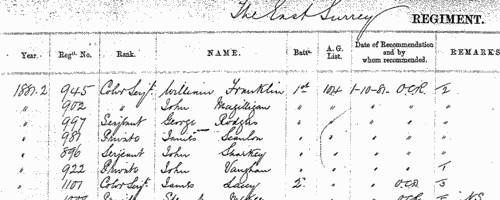
|  Outstanding soldiers of the 4th (The Queen's Own) Hussars
(1881-1901) Outstanding soldiers of the 4th (The Queen's Own) Hussars
(1881-1901)
Each year the best soldiers of the regiment were chosen for long service and good conduct medals. This register gives rank, name, regimental number, and date of recommendation. (The sample scan is from the East Surrey regiment). The register is essentially a register of recommendations, annotated with details of the issue of the medals. Where no gratuity accompanied the medal, the entry is marked 'W. G.' (without gratuity); where, for one reason or another, the medal was not issued, the entry is marked 'N. S.' (not sanctioned) and struck through. Having returned from India in 1878, the regiment was based at Norwich in 1885; at Aldershot in 1895. | Sample scan, click to enlarge
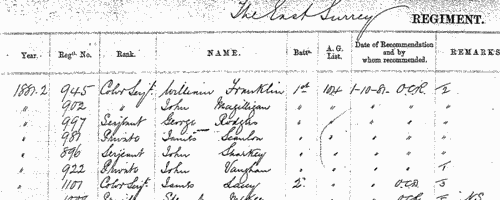
|  Outstanding soldiers of the British Army Staff Corps
(1881-1901) Outstanding soldiers of the British Army Staff Corps
(1881-1901)
Each year the best soldiers were chosen for long service and good conduct medals. This register gives rank, name, regimental number, and date of recommendation. (The sample scan is from the East Surrey regiment). The register is essentially a register of recommendations, annotated with details of the issue of the medals. Where no gratuity accompanied the medal, the entry is marked 'W. G.' (without gratuity); where, for one reason or another, the medal was not issued, the entry is marked 'N. S.' (not sanctioned) and struck through. | Sample scan, click to enlarge
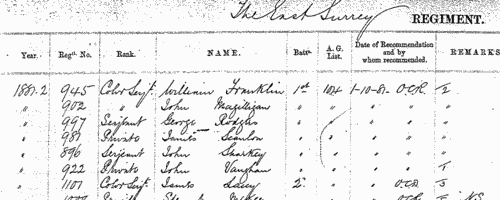
|  Outstanding soldiers of the Cheshire Regiment
(1881-1901) Outstanding soldiers of the Cheshire Regiment
(1881-1901)
Each year the best soldiers of the regiment were chosen for long service and good conduct medals. This register gives rank, name, regimental number, and date of recommendation. (The sample scan is from the East Surrey regiment). The register is essentially a register of recommendations, annotated with details of the issue of the medals. Where no gratuity accompanied the medal, the entry is marked 'W. G.' (without gratuity); where, for one reason or another, the medal was not issued, the entry is marked 'N. S.' (not sanctioned) and struck through. The regiment was based on Regimental District No. 22 - Chester. The 1st battalion was transferred to the Channel Islands in 1881, and returned to England in 1883: by 1885 it was stationed at Portland. The battalion embarked for Gibraltar 20 February 1885, and was sent on to Egypt in 1886, and in 1887 to India; having served in Burma from 1887 to 1891, it was at Bellary in Madras in 1895. The 2nd battalion embarked for India 7 October 1873; by 1885 was at Umballa, and transferred to Burma in October 1887, returning from there to England 8 February 1889. In 1895 the 2nd battalion was at Aldershot; it was sent to Ireland in 1895, and then in 1900 to South Africa, fighting at Bloemfontein, Johannesburg, Jacobsdal, Karree Siding, Brandfort, Vet River, Zand River, and in the Western Transvaal in 1901, adding "South Africa, 1900-1902" to the regimental honours.
| Sample scan, click to enlarge
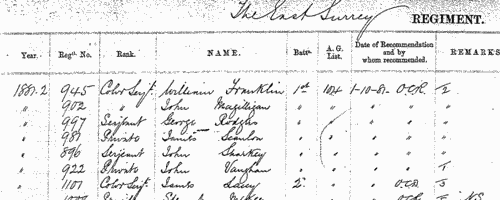
|  Outstanding soldiers of the Grenadier Guards
(1881-1901) Outstanding soldiers of the Grenadier Guards
(1881-1901)
Each year the best soldiers of the regiment were chosen for long service and good conduct medals. This register gives rank, name, regimental number, and date of recommendation. (The sample scan is from the East Surrey regiment). The register is essentially a register of recommendations, annotated with details of the issue of the medals. Where no gratuity accompanied the medal, the entry is marked 'W. G.' (without gratuity); where, for one reason or another, the medal was not issued, the entry is marked 'N. S.' (not sanctioned) and struck through. The 1st battalion returned from Canada in 1864, and by 1885 was based at Dublin, and in 1895 was at Wellington barracks. The 2nd battalion returned from Egypt in 1882, and in 1885 was at the Tower of London. After another period of service abroad, it returned from Bermuda in 1891, and in 1895 was at Chelsea barracks. The 3rd battalion served in Egypt and the Soudan, adding "Egypt, 1882", "Tel-el-Kebir" and "Suakin, 1885" to the regimental honours; it returned from Egypt 10 September 1885, and was stationed at Windsor, and by 1895 at the Tower of London. | Sample scan, click to enlarge
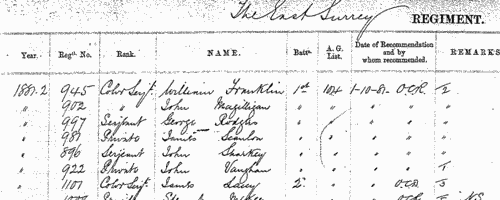
| Unclaimed Naval Prize Money
(1855-1902)
Various prize moneys were awarded to officers and men who served on board her Majesty's ships. For one reason or another a substantial number of these prizes, from as little as a shilling or two to as much as many pounds, remained undistributed by 1902, when this comprehensive list of the unclaimed moneys was printed: it lists unclaimed shares of prize money, slave and pirate bounties, salvage awards, parliamentary grants, gratuities and other moneys distributed by the Admiralty 1855 to 1902, but which omits moneys for service on the China Station during the war of 1856 to 1880, and special gratuities for service in Egypt (1882), Soudan (1884) and Soudan and Nile Expedition (1884-1885), for which there are separate indexes. In each case the sailor's name is given first (surname, then christian name or initials); rank or rating; ship in which serving at time of capture or award; and the amount due. | Sample scan, click to enlarge

|  British artillerymen fighting in South Africa
(1899-1902) British artillerymen fighting in South Africa
(1899-1902)
The Queen Victoria's South Africa Medal was awarded (after her death, in the event) to all who had served honourably in the various campaigns in the Boer War. Returns were made from each unit, and consolidated into nominal roll, of which this is the one for the Royal Artillery. Confusingly, the ledgers used had originally been printed for a register of men transferred (or re-transferred after mobilization) to 1st Class Army Reserve. All the original column headings were therefore struck through, and the roll was prepared with this information: Date of Issue; Regimental Number; Rank; Name; Unit; Medal (a 1 indicating that a medal was awarded); [number of] Clasps; the reference to the source in the original returns, usually starting with AG for papers in the hands of the Adjutant-General, and 68/Art/ for the Royal Artillery records. The final column, normally left blank, was occasionally used for explanatory remarks. | Sample scan, click to enlarge

|
Research your ancestry, family history, genealogy and one-name study by direct access to original records and archives indexed by surname.
|












